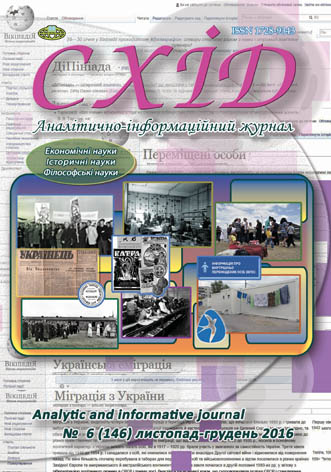The activities of the Russian Empire military schools on the territory of Ukraine during the early twentieth century
DOI:
https://doi.org/10.21847/1728-9343.2016.6(146).84075Keywords:
Ukrainian land, military school, junker, officer, training programAbstract
The article discusses the military schools activities and educational aspects of the officer corps formation of the Russian Empire in the Ukrainian lands of early ХХ century. The armed forces of each state in the world cannot be imagined without a command structure. The efficiency of the army depends on training and moral character of the officer contingent.
Graduates of military schools were considered the elite society of Imperial Russia, they were role models for the younger generation and a reliable pillar of the monarchical regime. However, after the collapse of the Russian Empire, many officers went into the national military forces of the Ukrainian People's Republic, West Ukrainian People's Republic, Ukrainian state.
The necessity of search of new conceptual bases of officer training in the Ukrainian Armed Forces dictates the feasibility of a comprehensive analysis of the main trends, characteristics of positive and negative features of training and education of officers in the past.
The author analyzes the system of training, the daily routine of military schools on the territory of Ukraine. The activities of state institutions Imperial Russia on the Ukrainian lands in our time is of interest to the public.Downloads
References
Allmendinger, V. V. (1971), Chuguev military school, available at: http://lepassemilitaire.ru/chuguevskoe-voennoe-uchilishhe-v-almendinger/
Beskrovnyy, L. G. (1973), The Russian army and Navy in the XIX century. Military-economic potential, available at: http://publ.lib.ru/ARCHIVES/B/BESKROVNYY_Lyubomir_Grigor%27evich/_Beskrovnyy_L.G..html
Beskrovnyy, L. G. (1986), Army and Navy of Russia in the early XX century. Military-economic potential, available at: http://publ.lib.ru/ARCHIVES/B/BESKROVNYY_Lyubomir_Grigor%27evich/_Beskrovnyy_L.G..html
Volkov, S.V. (1993), Russian officer corps, available at: http://swolkov.org/rok/index.htm
Vorobyeva, A.Yu. (2002), The Russian cadets, 1864 - 1917. History of military schools, available at: http://www.e-reading.club/book.php?book=1000763
Drozdovskiy, A. and Krasnova, E., The Odessa infantry cadet school. available at: http://wwwodessitclub.org/pu-blications/almanac/alm_48/alm_48_107_122.PDF
Galushko, Yu. and Kolesnikov, A. (1993), School of Russian officers, available at: http://books.academic.ru/book.nsf/62062548/
Golovan, V., 100 years of history of theOdessaartillery: 30 thousand officers, 250 generals, 41 hero of theSoviet Union, available at: http://vigolovan.livejournal.com/11556.html
Grekov, F.V., A brief historical sketch of military educational institutions. 1700-1910, available at: http://нэб.рф/catalog/000199_000009_004178340/
Zhuravlev, A. Yu. (2008), Training of the chief officers of the Russian army in the cadet military schools of the second half of XIX - early XX century, available at: http://www.dissercat.com/content/podgotovka-ober-ofitserskogo-sostava-russkoi-armii-v-yunkerskikh-voennykhuchilishchakh-vtor
Zayonchkovskiy, P.A. (1973), Autocracy and the Russian army in the XIX-XX centuries: 1881-1903, available at: http://www.regiment.ru/Lib/A/9/1.htm
Kamenev, A.I. (1990), History of officers training inRussia, available at: http://www.ruscadet.ru/library/01-books/kamenev/hist-prep.htm
Markov, A.L., The cadets and cadets, available at: http://booksonline.com.ua/view.php?book=117968
Mikhaylov, A.A. (1999), The management of the military education inRussiain second half XIX - early XX centuries, available at: http://detsky-lektory.ru/work/952413/Stanovlenie-i-razvitie-voennogo
Morozov,S.D., Military education inRussiaat the turn of XIX-XX centuries, available at: http://www.regiment.ru/Lib/-C/127.htm
Past unforgettable Glorious southern School. 1865-1965. Historical sketch of the Elisavetgrad cavalry school with the memories of pupils of the School to the centenary of the founding of the school, available at: http://genrogge.ru/elisavetgrad_kav_uchilishe/
Nikolaev, A. V. (2004), Тhe Development of physical education in military educational institutions of Russia in second half XIX - early XX centuries, available at: http://www.dslib.net/istoria-otechestva/razvitie-fizicheskogo-vospitanija-v-voenno-uchebnyh-zavedenijah-rossii-vo-vtoroj.html
Perepelovskiy, K. M., The Kiev Grand Prince Konstantin Konstantinovich, Military School, available at: http://militera.lib.ru/h/perepelovsky_k01/index.html
Petrakov, V. (2000), The fate of the standard of the Elisavetgrad cavalry school, available at: http://kladoiskateli.com /index.php?autocom=downloads&code=confirmdownload&id=1421&req=download
Polyanin, A.R. (2009), Нuman training of future officers in military educational institutions of the Russian Empire in the XVIII - early XX century, available at: http://www.dissercat.com/content/ gumanitarnaya-podgotovka-budushchikh-ofitserov-v-voenno-uchebnykh-zavedeniyakh-rossiiskoi-im
The orders of the war Department. Order No. 197 dated June 14,1901, St. Petersburg, 1901.
Terkun, A.N. (1999), Military training in Russia, available at: http://нэб.рф/catalog/000199_000009_000251279/?PAGEN_1=1
Samusenko, V.N. (2005), The historical experience of military educational institutions of Russia in second half XIX - early XX century on the formation of moral-combat qualities of officers, available at: http://www.dslib.net/istoria-otechestva/istoricheskij-opyt-dejatelnosti-voenno-uchebnyh-zavedenij-rossii-vtoroj-poloviny.html
The collection of orders by the war Department (1910), SPb., р. 378.
Tsauder P.,Odessamilitary school, available at: http://www.odessapage.com/new/ru/node/1339#comment-399
Shlyakhovoy, K.V., Elisavetgrad cavalry cadet school, available at: http://genrog-ge.ru/memo/eku.htm
Downloads
Published
How to Cite
Issue
Section
License
Copyright (c) 2017 Eduard Melnykov

This work is licensed under a Creative Commons Attribution-NonCommercial-NoDerivatives 4.0 International License.
1. Authors bear responsibility for the accuracy of facts, quotations, numbers and names used.
2. Manuscripts are not sent back.
3. The publisher does not always agree with the authors' opinion.
4. The authors reserve the right to authorship of the work and pass the first publication right of this work to the journal under the terms of a Creative Commons Attribution-NonCommercial-NoDerivatives 4.0 International License. This license allows others to distribute (copy) the published work for non-commercial purposes, provided there is mandatory attribution to its authors and a link to the first publication in our journal.
5. The authors have the right to conclude separate supplement agreements that relate to non-exclusive work distribution in the form in which it has been published by the journal (for example, to upload the work to the online storage of the journal or publish it as part of a monograph), provided that the reference to the first publication of the work in this journal is included.

